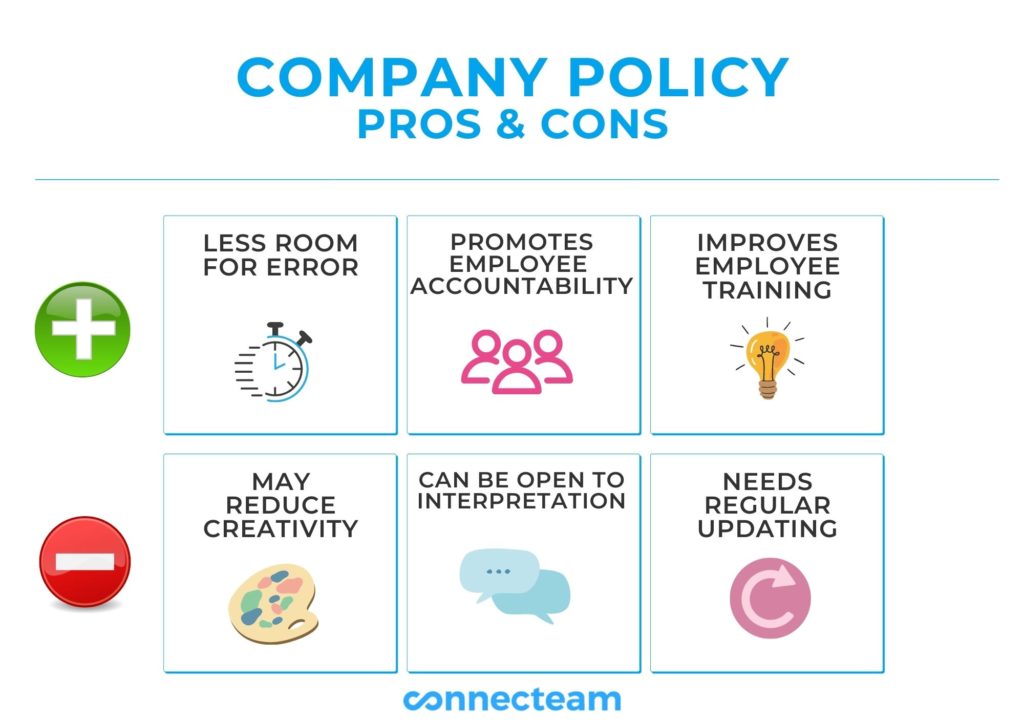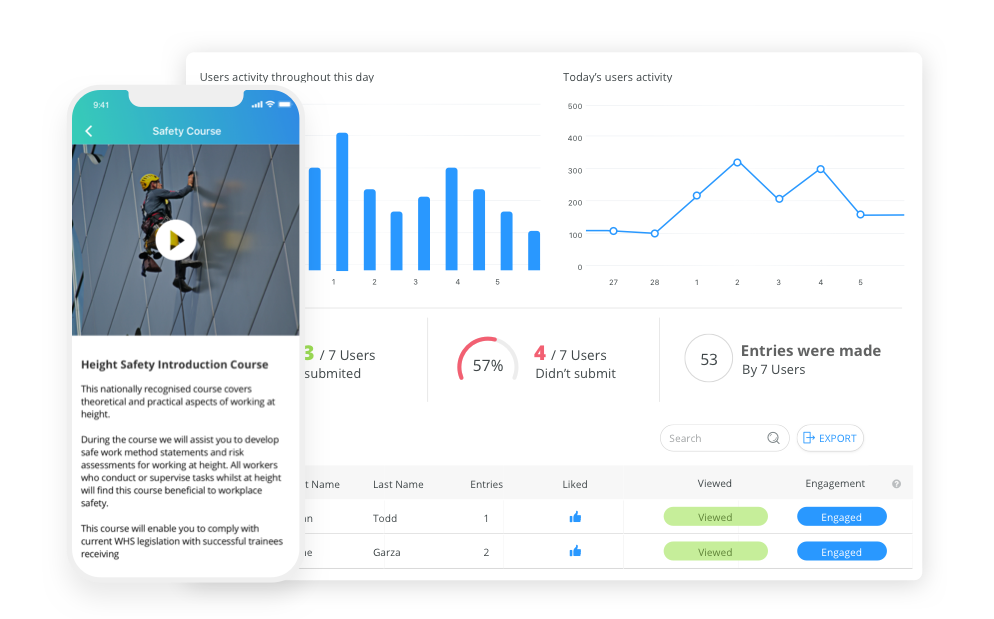It’s important for business owners and HR managers to regulate all aspects of their company’s operations. While policy templates are helpful, in theory, we don’t recommend relying on them to do the work for you. We’re going to show you how to prepare, write and implement your very own company policy, with examples included.
Running a business can be like walking through a minefield. At any point, you could stumble across issues that prove to be explosive for your company.
Incidents occur in all businesses, but a company policy can help you get back on your feet.
As such, we are aware that writing policies and procedures can be boring and tedious. But trust us, if you have an effective policy in place, you are going to keep your employees safe – professionally, personally, physically, and legally.
And if you’re a business owner or HR manager looking to create company policies that actually make a difference, then look no further. We have put together some key tips you can use to prepare, write and implement policies that suit your business model.
But before you get started, it’s important to understand why you might need to create your own company policy.
Why Is It Important To Write A Company Policy?
There are multiple reasons as to why all companies should create and implement policies that their employees should follow.
Great First Impression For New Employees
According to studies, 22% of employee turnover happens during the first 45 days of employment, so first impressions are everything. One of the first things new employees should receive is all relevant company policies. Onboarding new employees with the key goals and objectives early on will set the tone and pace for their employment.
Everyone’s On The Same Page
A company policy is a unique opportunity to ensure that all employees are on the same page when it comes to the company’s goals, values and rules.
Reduces Stress
When employees follow a policy, they are less likely to make needless mistakes, misunderstandings. This makes work less stressful for the employees and management.
All Decisions Are Fair
If all employees are required to read, accept and follow the same company policy, they are working in an environment that is fair and just. No one is punished arbitrarily.
Provides Legal Security
A company policy can make your employees feel in safe hands, especially if it clearly states their rights and duties. A policy that promotes accountability and employee relationship management improves transparency across the board.
Improves Employee Loyalty
A company policy can ensure that workers stay devoted to the company’s cause, especially if employee benefits are included.

Across multiple industries, large numbers of new employees are notorious for failing to read company policies (such as employee handbooks) during onboarding. This is evident from the infographic above.
How To Prepare A Company Policy
Unfortunately, you can’t simply start writing away and expect to have a perfect policy as the end result. Business owners need to carefully prepare exactly what they will include and how they will express this to all necessary parties. Putting the following steps in place can make all the difference.
All Parties Should Agree To Develop The Company Policy
Whether you started a construction business or a hotel, management and employees need to express unanimous support for the proposed company policy. Valid reasons should be put forth to argue for the policy in question. Once it has been agreed upon by all parties, the real planning can begin.
Assemble A Company Policy-Building Team
A company policy should always be a collaborative effort. The more people who contribute ideas, the more unified the final message of the policy will be. But you can’t just recruit anyone for the job. It’s important to use good managers and staff who are experts on the topic in question.
Build A Standard Company Policy Structure
One of the most important pieces of preparation to have in place is to ensure that the company has a standardized company policy structure. This structure will vary depending on the company’s needs, But regardless of whether you’re a retail manager or a plumber, it should include the policy’s goals, guidelines and who it applies to.

Create A Priority List
You might need to create multiple company policies covering a wide variety of topics and needs. So in order to prevent your company policy-building team from becoming overwhelmed, try prioritizing policies in order of which one your company needs first. Any policy that provides short term benefits should come first on the priority list. Whether you’re training cleaning staff or managing manufacturer workers, you need to brainstorm which policies need immediate attention.
Do Your Research
You need to do your homework before you start writing a company policy. Having an in-depth knowledge on both your company and the topics you wish to cover in the policy is paramount. Research can also help to improve company policies that are already in place, filling in gaps with relevant information.
Here are a couple of ways that you can perform research for a company policy:
- Consult experts about relevant topics.
- Perform company surveys and interview employees.
- Stay up to date with the latest laws that are relevant to policies you wish to create/update (such as meal and rest break laws by state).

How To Write A Policy For Your Company
When talking about how to write a policy for your company, it’s important to ensure that you tick all the boxes and include all details that both the employer and employee should follow.
Generally speaking, employers should consider including the following components to every company policy.
Purpose Statement
This explains to the reader why the company is implementing the policy to begin with and the goals it aims to achieve by using it.
Specifications Section
This part of the company policy includes specific rules, guidelines and regulatory changes that employees should follow. For example, “Employees are expected to dress in store uniforms from Monday until Friday. Staff are permitted to follow a business casual dress code on Saturdays.”
Implementation Section
This section clearly states which parties are expected to follow the policy and the means by which they can follow it. “Restaurant managers are permitted to determine whether or not attire is appropriate.”
Effective Date
The date that the company policy takes effect. For example, “All parties are subject to follow this policy as of January 1st 2024.”
Glossary
A list of common terms used throughout the company policy, including definitions. For example, “uniform: professional attire provided by the retail company.”
It’s worth noting though that a policy shouldn’t be mistaken as a contract or a list of rigid rules that should be followed exactly how they are written. A company policy should be written with flexible language, making it easy and welcoming for employees to follow.

How To Format & Style A Company Policy
It’s not just about what you write in your company policy. The style and format in which you write it also improves readability, and therefore improves employee engagement.
Here are some important formatting tips when writing a policy:
- Select a professional font such as Arial, Calibri, Georgia or Times New Roman, for example.
- Choose a font size that is easy to read (size 12) and consistent throughout the document (headings, titles, subheadings excluded).
- Avoid using lots of colors to give the document a professional look. Stick to black font on a white background.
- Space out paragraphs and sections appropriately.
It doesn’t matter if you started a real estate business or if you are a handyman. When it comes to the company policy’s writing style, there are a few important things to look out for:
- Write the policy clearly and to the point.
- Write it in third person – for example, “he,” “she” and “it.”
- If you are writing about an organization (for example, the World Health Organization), make sure to write it in its entirety, and then you can include the actual acronym (WHO) at the end.
- Absolute words such as “will,” “must,” “only,” “always,” and “never” shouldn’t be used when describing how employees should act. Instead, employers should resort to using terms like “usually,” “generally,” and “might,” to allow managers to be more flexible when handling different situations.
Review Your Draft & Get Approval
A vital part of writing a company policy is the reviewing process. Give the entire policy-building team a chance to edit the first draft, provide feedback, spot mistakes and add anything that might be missing.
When the team is happy with the final draft, forward it to an executive member of the company to approve it.
Once you have formulated your company policy, you need to think about how you are going to implement it.
Use The Best Tools To Implement Your Company Policy
It’s crucial to consider how you will share your company policy with the rest of your company. Printing it every time you hire someone is just tedious. Also, employees can easily lose a printed version, and this is definitely something you want all parties to have easy access to.
Connecteam is an award-winning management app designed specifically for the mobile workforce – such as remote teams and deskless workers.

More than 20,000 companies from over 90 industries use Connecteam’s all-in-one training management app to create documents and policies and easily distribute them to every employee, no matter where they are working. If you already have a paper form or file, upload or take a picture of it and Connecteam’s AI will automatically convert it into a structured, digital version.
Here are just some of benefits that Connecteam brings:
- If an employee needs to review a policy, they can simply refer to the app instead wasting their time with messy, cluttered paper documents.
- Employees can add a signature and pictures to the digital form to ensure everything is covered.
- Connecteam has time management (including QuickBooks Online and Gusto integration for smooth payroll), team communication, and knowledge center capabilities, ticking all of the boxes to meet your company’s needs.
- This all-in-one AI employee training software is free to use.
Connecteam provides business owners and HR with the necessary tools to digitize company policy and update it as much as you need, with no printing required.
Teach Company Policy To Your Employees
Connecteam lets you create your very own knowledge base for the entire team, which is where you can attach all of your company policies in real time. You can even search for specific policies by keyword. It’s accessible on employees’ own mobile phone so they have direct access to the policy at any time (from the second you update it).
Reduce clutter and provide employees with specific learning resources. Assign multiple knowledge bases to different departments, as well as multiple sections with folders, sub-folders, items and files.
Communicate With Your Team About Your Company Policy
A step to implementing a company policy that is often overlooked is communicating it effectively to your employees. It’s not enough to simply force policies upon a company’s staff. You need to clearly convey the value of the policy and why it’s important for all parties to follow it in the first place.
While meetings, memos and e-mails are all valid ways to update employees, employee engagement software can make communication more effective and efficient.
Connecteam also allows managers to send simple, engaging company updates that employees can enjoy and understand, using images, videos and other files. Also, they can see which employees read the update and easily follow up with reminders or through the 1:1 chat, if required.

Upload Your Company Policy And Update Your Employees On The Go
Update Your Company Policy
Even after you have finished writing, reviewing and implementing it, your policy is still not set in stone. It should be a living, breathing document that you update as you go along.
This especially applies when governments and states pass new laws that might affect your company. For example, if the minimum wage in the state your company is located in changes, then you might want to include in your company policy on how the company would handle this moving forward. (And once you update the policy in Connecteam, all of your employees have the latest, up to date version.)
Frequently Asked Questions About Company Policy
What Exactly Is A Company Policy?
In general, a company policy is a document that includes instructions on how to do certain things in your business properly.
Company policies help shape the decisions that business owners and employees make on a daily basis. It can influence multiple aspects of company life such as work ethic, company culture, office behavior, and health and safety.
Every company requires its own unique set of policies, depending on the goals it has set, both short and long term, as well as its overarching mission.
What Examples Of Company Policies Should My Company Use?
The industry your business is in and your company’s needs are going to determine what kind of company policies you need to create. And there are so many different examples of company policies. While not all of them will apply to your specific company, many of the following company policies can be found in most companies, in some shape or form:
- Workplace safety policies (based on city/country/state/federal laws)
- Employee conduct (dress code, harassment policy, safety procedures, appropriate behavior)
- Job descriptions
- Personnel policy (work hours, employment terms, state wages, salary/bonuses, vacations/sick leave/maternity leave, insurance/benefits, retirement plan)
- Company governance (company culture and values)
- Company structure (chart illustrating every employee’s name and which department they work in)
- Equal opportunity/non-discrimination policy (race, gender, sexual orientation, religion, culture)
- Attendance policy (schedules, time off, workplace absenteeism)
- Substance abuse policy (alcohol, drugs, tobacco)
- Disciplinary policy (poor performance, misconduct, dishonesty)
- Technology policy (devices, mobile phones, e-mail, internet)
- Finance policy (different types of compensation, benefits, retroactive pay, spending authorization)
- Privacy policy
- Customer service policy
It’s worth noting that this list doesn’t include all of the policies that companies use. But a lot of company policies fall under the aforementioned company policy examples.
The Bottom Line On Writing A Company Policy
As a business owner (or HR manager), we understand if you might be overwhelmed by all of the steps provided.
While this might seem like a lot to follow, especially if you’re writing your very first company policy, we recommend taking your time and seeing what works for you. Ultimately, the more detailed the policy is, the safer your staff members will be. The best company policies take time, expertise and manpower to build.
But once you do have your company policy in place, implementing it can be quick, easy and affordable. Using a digital solution like Connecteam allows managers and employees alike to have easy access to your policies.
With just a couple of clicks, you can download, read and sign all relevant documents. Also, you can use this communication app to initiate dialogue about the policy, submit feedback to improve it, and send reminders to make sure everyone has read and understood it.
So put aside your pens and paper, and start digitizing – because preparing, writing and implementing company policy has never been easier.





